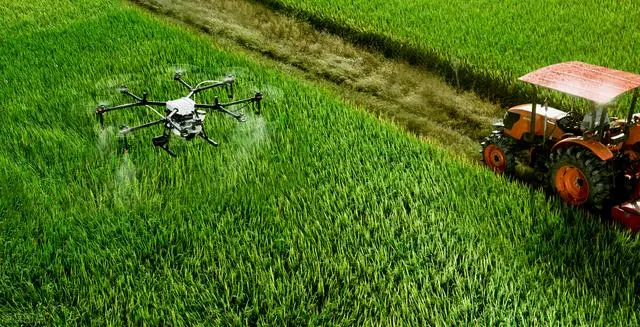With the development of technology, industry application level drones have begun to become popular and are gradually being widely used in various fields. Among them, plant protection drones play an important role in the agricultural field.
Firstly, plant protection drones can replace human labor and have high safety. Compared with manual operations, plant protection drones can reduce labor intensity and provide feasible solutions for rural areas with high labor costs and labor shortages. At the same time, the plant protection drone can be remotely operated, avoiding the danger of spraying operators being exposed to pesticides and ensuring the safety of the operation.
Secondly, plant protection drones can save resources and reduce pollution. The spraying technology adopts the spray spraying method. The UAV has the characteristics of low operating height, less drift, and hovering in the air. The downward airflow generated by the rotor during pesticide spraying helps to increase the penetration of the fog flow to crops, with good control effect. At the same time, it can save 50% of the pesticide usage and 90% of the water consumption, greatly reducing the resource cost.
Thirdly, plant protection drones have strong adaptability and are easy to promote. It is suitable for low stem crops such as wheat, soybeans, and rice, as well as high stem crops such as corn, cotton, sorghum, and forest fruit belts. It is also suitable for operations in hilly and mountainous areas. Due to its strong adaptability, without the need for a dedicated terminal, it can fly near the ground and hover in the air. It is small in size and light in weight, and can be used for cross regional transfer operations with a van, making it easy to promote and popularize.
Fourthly, plant protection drones have excellent prevention and control effects. The downward airflow generated by drone flight can blow the blades, allowing both the front and back sides of the blades to be coated with pesticides. The prevention and control effect is improved by 15% to 35% compared to manual and mechanical methods, and the prevention and control effect for sudden and explosive diseases and pests is good, not limited by crop growth.
Finally, plant protection drones have efficient automation characteristics. With the transfer of land, more and more large farms will continue to emerge, requiring higher levels of mechanization and automation in the planting industry. The plant protection drone operation adopts flight control navigation for autonomous operation. Before spraying, the GPS information of crops in the farmland is collected into the control program and the route is planned. The drone can basically achieve automatic operation, reducing the difficulty of operation for operators.
The drone technology in agriculture is an important component of agricultural production in relevant departments, and the application of drones in agriculture will continue to increase. Agricultural drones have a high degree of automation mainly through remote control or GPS flight control, and have good development prospects.
Intelligence and Autonomy: In the future, plant protection drones will become increasingly intelligent and autonomous, not only able to operate and fly independently, but also able to obtain data through sensors for real-time analysis and decision-making. In addition, future agricultural drones will have the potential to achieve autonomous obstacle avoidance, autonomous takeoff and landing, and other functions, thereby further improving operational efficiency and safety.
Multifunctionality: In the future, plant protection drones will not only be tools for pesticide and fertilizer spraying in plant protection operations, but also be able to carry more sensors and equipment to achieve various functions, such as farmland monitoring, soil testing, sowing, etc. This will contribute to the comprehensive upgrading and intelligence of agricultural production.
The development of future agricultural drones will continue to make new progress in terms of load-bearing capacity, intelligence, versatility, efficiency, and environmental protection. At the same time, according to specific operational and market demands, the size, body structure, and materials of agricultural drones will also undergo changes and upgrades.







Please sign in to comment
register